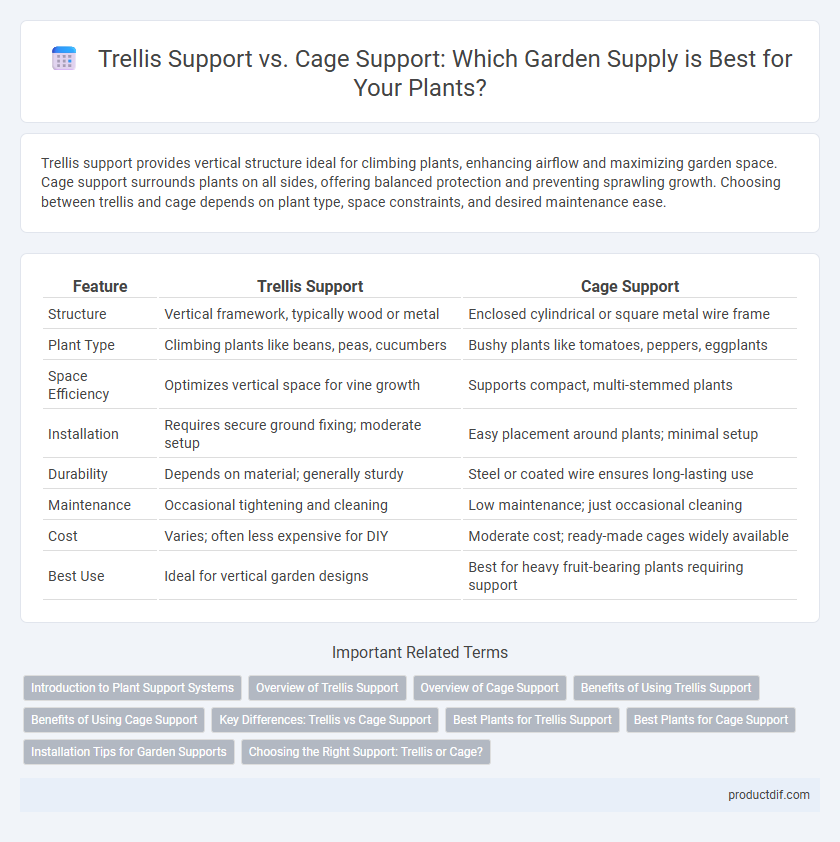Trellis support provides vertical structure ideal for climbing plants, enhancing airflow and maximizing garden space. Cage support surrounds plants on all sides, offering balanced protection and preventing sprawling growth. Choosing between trellis and cage depends on plant type, space constraints, and desired maintenance ease.
Table of Comparison
| Feature | Trellis Support | Cage Support |
|---|---|---|
| Structure | Vertical framework, typically wood or metal | Enclosed cylindrical or square metal wire frame |
| Plant Type | Climbing plants like beans, peas, cucumbers | Bushy plants like tomatoes, peppers, eggplants |
| Space Efficiency | Optimizes vertical space for vine growth | Supports compact, multi-stemmed plants |
| Installation | Requires secure ground fixing; moderate setup | Easy placement around plants; minimal setup |
| Durability | Depends on material; generally sturdy | Steel or coated wire ensures long-lasting use |
| Maintenance | Occasional tightening and cleaning | Low maintenance; just occasional cleaning |
| Cost | Varies; often less expensive for DIY | Moderate cost; ready-made cages widely available |
| Best Use | Ideal for vertical garden designs | Best for heavy fruit-bearing plants requiring support |
Introduction to Plant Support Systems
Trellis support systems consist of vertical frames or lattices that guide climbing plants, such as peas and cucumbers, encouraging upward growth and improving air circulation. Cage supports, commonly used for plants like tomatoes, provide a sturdy, circular framework surrounding the plant to prevent sprawling and support fruit weight. Both systems enhance plant health by reducing disease risk and maximizing space efficiency in garden beds.
Overview of Trellis Support
Trellis support provides vertical structure ideal for climbing plants like tomatoes, cucumbers, and beans, maximizing garden space and improving air circulation. Constructed from materials such as wood, metal, or plastic, trellises can be customized to suit different plant growth habits and garden aesthetics. This type of support enhances sunlight exposure and eases harvesting, making it a practical choice for both small home gardens and larger agricultural setups.
Overview of Cage Support
Cage support provides sturdy, cylindrical frameworks designed to encircle plants, promoting vertical growth and preventing stem damage. Unlike trellis supports, cages offer 360-degree protection, making them ideal for tomatoes, peppers, and other bushy vegetables. Their durable construction often features heavy-gauge wire, ensuring long-lasting stability throughout the growing season.
Benefits of Using Trellis Support
Trellis support enhances plant growth by providing vertical structure, improving air circulation and exposure to sunlight, which reduces the risk of disease. Unlike cage support, trellises offer customizable height and spacing, accommodating various vine lengths and promoting higher yields. They also simplify harvesting and maintenance by keeping plants upright and organized within garden beds.
Benefits of Using Cage Support
Cage support offers superior stability for plants like tomatoes and peppers, reducing the risk of stem breakage and promoting healthier growth by providing 360-degree support. This method improves air circulation around the plant, which helps prevent fungal diseases and enhances fruit ripening. Unlike trellis support, cages require less maintenance and adjust with the plant as it grows, making them ideal for home gardeners seeking efficient and reliable garden support solutions.
Key Differences: Trellis vs Cage Support
Trellis support provides vertical structure ideal for climbing plants like tomatoes and cucumbers, optimizing space and air circulation while promoting healthy growth. Cage support surrounds plants closer and offers 360-degree support, crucial for heavy or bushy plants that require containment to prevent sprawling. The key difference lies in trellises facilitating upward growth with open framework, whereas cages provide enclosures that protect and shape plant development.
Best Plants for Trellis Support
Trellis support is ideal for climbing plants like peas, beans, cucumbers, and tomatoes that require vertical growth to maximize space and improve air circulation. Unlike cage support, which primarily suits bushy or sprawling plants such as peppers and indeterminate tomatoes, trellises provide strong, stable frameworks for vines to latch onto. Choosing a trellis for plants like passionfruit and grapes enhances sunlight exposure and fruit quality, making it the best support option for vigorous climbers.
Best Plants for Cage Support
Cage supports are ideal for plants that require vertical growth and strong containment, such as tomatoes, peppers, and cucumbers. These sturdy metal or plastic cages prevent sprawling and promote better air circulation, reducing the risk of disease in vine-heavy plants. Gardeners prefer cage support for indeterminate tomato varieties and heavy-fruiting pepper plants because it offers consistent stability throughout the growing season.
Installation Tips for Garden Supports
When installing trellis supports, anchor them firmly into the soil using sturdy stakes or posts to ensure stability against wind and plant weight. Cage supports require placing the cage around young plants early in their growth to avoid damaging roots during setup. Both methods benefit from securing ties or clips at multiple points to prevent shifting and promote proper plant training.
Choosing the Right Support: Trellis or Cage?
Choosing the right garden support hinges on plant type and growth habit, where trellises excel for vertical climbing plants like beans and grapes, providing ample airflow and sunlight exposure. Cage supports, often constructed from wire or metal, offer sturdy protection for bushy or sprawling plants such as tomatoes, preventing breakage and maintaining fruit accessibility. Understanding your plant's growth pattern and space constraints ensures optimal yield and healthy development by selecting a trellis or cage tailored to structural needs.
Trellis support vs Cage support Infographic

 productdif.com
productdif.com